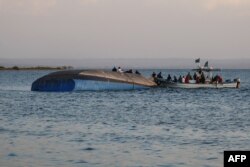The death toll rose to 167 and one survivor was reportedly rescued Saturday from the ferry that capsized in Tanzania's Lake Victoria Thursday.
Tanzanian officials continued their search inside the overturned vessel for a third day Saturday as an investigation into the disaster got underway.
Search teams spent the day pulling bodies from the MV Nyerere, which sank amid speculation it was overcrowded, as four days of mourning began for victims.
The Associated Press reported Saturday that one man was pulled alive from the wreckage. The wire service said the vessel's engineer was rescued near the engine. There was no report on his condition.
Tanzania's chief secretary, John Kijazi, had told reporters the ferry had a passenger capacity of 101. Kijazi said that he ordered an investigation into the incident and that charges would be filed against those found responsible.
Regional commissioner John Mongella said Friday he would not "speculate" on how many people were aboard the MV Nyerere, but it is not uncommon for watercraft to carry hundreds of passengers at a time. Local media say the ferry might have been carrying 200 passengers when it capsized. He said at least 40 people were rescued shortly after the Thursday accident and that some of those individuals were in “very bad condition.”
Tanzania's state radio reported passengers boarded the ferry at Bugolora, a town on Ukerewe Island, and were en route to the island of Ukara when the vessel overturned.
History of deadly ferry incidents
The cause of the sinking has not been determined, but overcrowding often has been faulted in previous cases.
In 1996, according to Tanzanian government records, about 800 people were killed when the MV Bukoba capsized on Lake Victoria.
In 2011, hundreds were confirmed dead when the MV Spice Islander I sank off the coast of the archipelago of Zanzibar.
Lax safety measures?
Mbaki Farki, a diver in Tanzania who participated in the 2011 rescue operation, told VOA's Swahili Service that the ferry fleet on Lake Victoria lacks safety precautions.
Ferries are supposed to have life jackets and life rings, but the fleet has insufficient equipment, Farki said. He added that the vessels also lack services for people with disabilities, among the most vulnerable in such incidents.
“I am asking the government to prepare rescue teams in Tanzania because we have the marines, police and navy," Farki said. "We need to have rescue teams everywhere so that we can deal with these kinds of tragedies. In Tanzania, we look for help and rescue teams only when tragedy strikes."
The Tanzanian Red Cross Society has been working on rescue and recovery. Godfrida Jola, a spokeswoman, told VOA that the organization had helped rescue 35 people but also was trying to deliver body bags for the dead.
Many of the victims did not know how to swim, Jola said, describing it as a widespread problem that the Red Cross would address to safeguard against further tragedy.
"At Red Cross, we have taken it as a lesson learned — and on our program we are going to work together with those communities to prepare them ... so that they can be able to swim," Jola said.
Charles Misango, lost 11 members of his family when the MV Nyerere capsized, he told VOA's Swahili service. He challenged President John Magufuli's government to accept responsibility for the disaster.
A spokesman for the president said Magufuli was "deeply saddened" by the tragedy and urged citizens to "stay calm during these difficult times."
John Mnyika, of the main opposition party Chadema, accused the government of dereliction. "We have often raised concerns about the poor condition of this ferry, but the government turned a deaf ear," he said. "We have repeatedly denounced this negligence."
The VOA Swahili Service's Sunday Shomari and Idd Ligongo contributed to this report.










